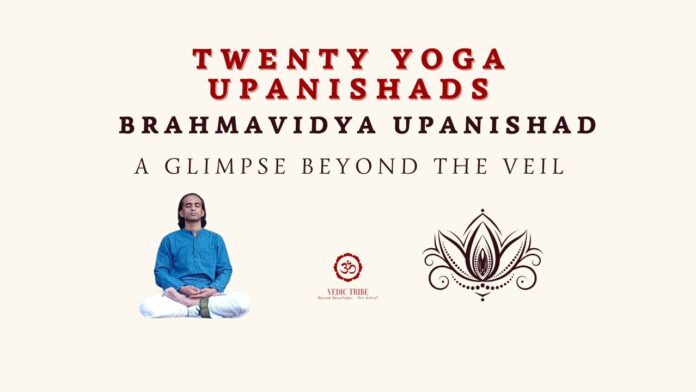A Glimpse Beyond the Veil:
In the previous article, we discussed Dhyanabindu Upanishad and in this article, we will discuss – Brahmavidya Upanishad.
The Brahmavidya Upanishad places emphasis on the meditation technique involving the contemplation of five different dimensions of the Supreme Being (Brahman) within the human body.
It is a significant text enabling us to look beyond the veil of physical body and observe the conscious consciousness residing within.
The Hamsa Vidya enumerated in this Upanishad is also found in “Hamsa Upanishad” and is separately discussed in our article titled “Hamsa Upanishad”.
What is Brahma and Brahman?
Deity: In popular culture, Brahma is one of the Trimurti i.e., trinity – Brahma-Vishnu-Maheshwara. He is the first one to enter the creation and to manage whole of the creation process. He is also called Prajapati, Virinchi, Chaturmukha Brahma…etc.
Almighty: The “Brahman” contemplated by the Upanishads is the cosmic consciousness. It is both immanent, meaning present within the universe, and transcendent, meaning existing beyond it. The term is derived from the Sanskrit root word “Bruh,” which indicates – biggest of all, that which grows / expands / manifests eternally.
Meditation in Upanishad involves directing one’s awareness towards this ultimate reality, seeking to experience its nature. it’s about cultivating a state of deep awareness and stillness, allowing the mind to transcend its limitations and connect with the absolute.
Meditation on “om”:
In this Upanishad – three aspects of “Om” is meditated upon:
Phoneme A: Representing Rig-Veda; sacred fire Garhapatya; the realm of earth; and the almighty in Brahma
Phoneme U: Representing Yajur-Veda; sacred fire Dakshnina; the realm of sky; and the almighty as Vishnu
Phoneme M: Representing Sama-Veda; sacred fire Ahavaniya; the realm of outer space; and almighty in Rudra.
Trimurti:
It must be noted that the idea of “Trimurti” in the Upanishad is also found in Puranic texts. This represents two manifestations of almighty (in Brahma and Rudra) and one direct manifestation (Vishnu).
Brahma: The term “Brahma” indicates the highest consciousness bound to creation (also called Prajapati / Virinchi / Chaturmukha Brahma)
Vishnu: The term “Vishnu” represents Brahman’s ability to enter the inanimate cosmos & to bring it alive. It also indicates Brahman’s attribute to pervade the cosmos and also to dwell in it at the same time.
Rudra: The term “Rudra” represents the terrifying cosmic sound and Brahman’s ability to punish immoral beings and to make them cry or weep.
Key takeaways:
– Study Brahmavidya Upanishad and adopt its teachings in your meditation
– Also study Bhagavad Gita to gain more insights into the teachings of this Upanishad
In the next article, we will discuss – “Yogatattva Upanishad”.
Madhwesh K
Vedic Tribe

